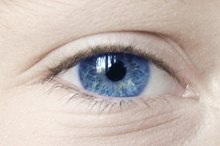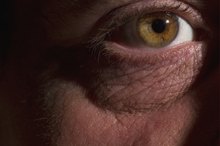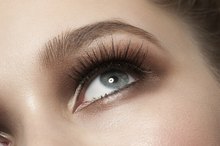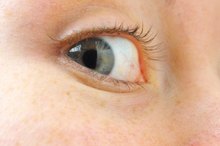Eye Floaters and Excess Protein
By the time you reach a certain age, in your teens or early 20s, you will have most likely experienced floaters in your field of vision. Floaters are those tiny dots, strands and "cobwebs" of protein that drift in and out of view from time to time. Although they can be annoying, for the most part they are harmless. However, if you notice a marked increase in floaters or if they are accompanied by flashing lights, call your doctor immediately.
The Vitreous Humor
The eye is filled with a viscous protein gel called the vitreous humor. It makes up about two-thirds of the volume of the eye and is mostly water, according to St. Luke's Cataract and Laser Institute. The vitreous humor is what gives the eyeball its shape. Early in life, the vitreous humor is thicker, having the consistency of an egg white. With age, it begins to thin out and become more liquid. As the vitreous humor becomes more liquid, little pieces pull away from the retina, causing the formation of floaters.
- The eye is filled with a viscous protein gel called the vitreous humor.
- The vitreous humor is what gives the eyeball its shape.
Causes of Floaters
What Do Black Spots in Vision Mean?
Learn More
You may first begin to notice eye floaters in your early 20s, or earlier if you are near-sighted. You can have them in one or both eyes, and they are so-named because they appear to "float" around aimlessly. You cannot focus on them because they move with the eye itself. They are small bits of protein, including pieces of vitreous humor, white blood cells and even blood, according to the University of Illinois. As floaters drift through the vitreous humor, they cast a shadow on the retina, making them appear visible. Eye floaters are most noticeable when you look at the bright sky or a blank white wall.
- You may first begin to notice eye floaters in your early 20s, or earlier if you are near-sighted.
- As floaters drift through the vitreous humor, they cast a shadow on the retina, making them appear visible.
Treatment
While they certainly can be annoying, for the most part eye floaters are considered a normal part of aging. Although they never completely go away, most will drift down to the bottom of the vitreous humor out of your line of sight, only bothering you occasionally. There is no treatment for the typical eye floaters. In extreme cases, where there are a multitude of floaters interfering with vision, it's possible to have the vitreous humor replaced with a solution of saline. This surgery is very risky and not performed routinely.
- While they certainly can be annoying, for the most part eye floaters are considered a normal part of aging.
- There is no treatment for the typical eye floaters.
Emergency Situation
What Causes Eye Floaters in Vision?
Learn More
In some cases, floaters can be an indicator of a more serious problem. If you experience a shower of new floaters in your vision accompanied by flashing lights, you should contact your doctor right away. It's possible your retina is torn or pulled completely away in one spot. This is called a torn or detached retina. The All About Vision website states this can cause of a loss of blood supply to the retina, resulting in loss of vision. If it is not treated immediately, this vision loss can be permanent.
- In some cases, floaters can be an indicator of a more serious problem.
- The All About Vision website states this can cause of a loss of blood supply to the retina, resulting in loss of vision.
Related Articles
References
- University of Illinois: Floaters
- Natural Eye Care: Eye Floaters
- All About Vision: Eye Floaters
- NIH National Eye Institute. At a glance: Floaters. Updated July 5, 2019.
- American Academy of Opthalmology. What are floaters and flashes? Updated August 23, 2019.
- Harvard Health Publishing. What you can do about floaters and flashes in the eye. Updated June 10, 2013.
- Bergstrom R, Czyz CN. Vitreous floaters. In: StatPearls [Internet]. Updated February 21, 2020.
- Primary Care of the Posterior Segment, Third Edition, Alexander, Larry, McGraw-Hill Publishing, 2002.
Writer Bio
Kathryn Meininger began writing and publishing poetry in 1967. She was co-founder and editor of the professional magazine "Footsteps" and began writing articles online in 2010. She earned a Doctor of Podiatric Medicine from Temple University School of Podiatric Medicine and a Bachelor of Arts in biology from William Paterson University.







